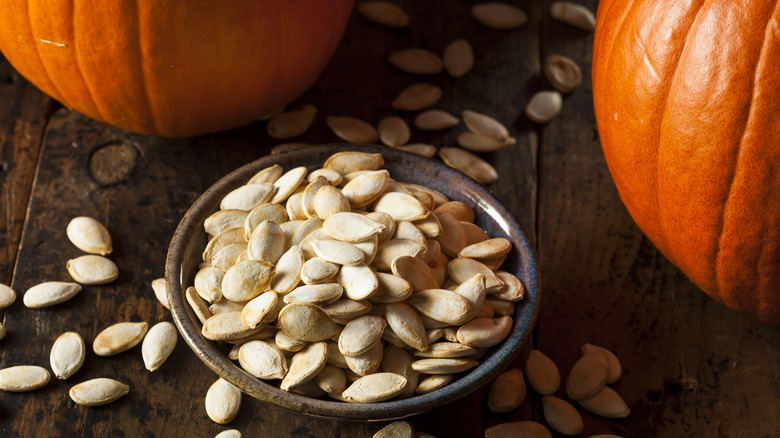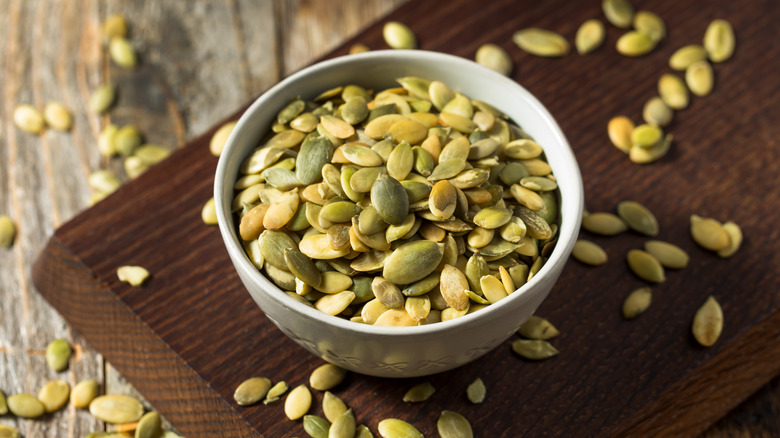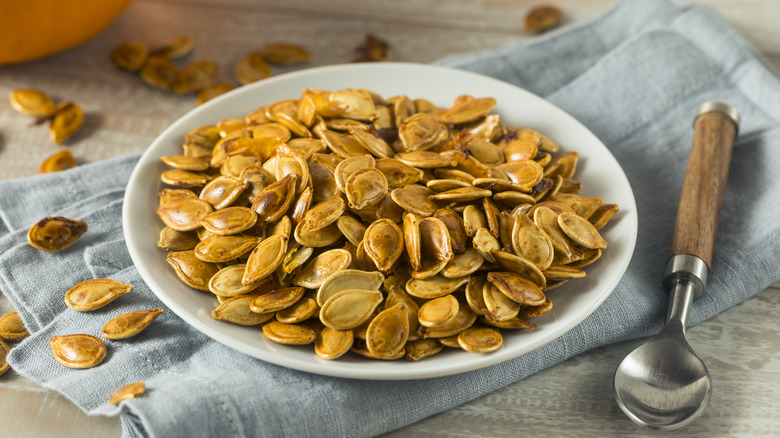How To Tell Pepitas And Pumpkin Seeds Apart
"Pepitas" is a term that's casually used for pumpkin seeds, especially of the roasted variety, but not all pumpkin seeds are pepitas. While the term "pumpkin seed" can refer to any seed harvested from the gooey innards of a squash, "pepita" only refers to the seeds of specific varieties. These particular pips lack the protective outer layer known as a hull, making for a difference in appearance between pepitas and other pumpkin seeds, as well each type's uses in the kitchen.
Because pepitas are not encased in a tough shell, they can be enjoyed raw, making them a quick and easy add-in for a wide variety of dishes. Pumpkin seeds, however, have a firm exterior that requires extra preparation to get them ready to consume. Both seeds are oval-shaped and fairly flat, but pumpkin seeds have a lighter color, versus the darker hue of pepitas.
The presence of a hull affects not just the color, but texture and taste of the seeds, too. One commonality is that both pumpkin seeds and pepitas are packed with nutrients, including omega-3 fatty acids, antioxidants, magnesium, fiber, and tryptophan. They are each credited with supporting a healthy immune system, sleep schedule, and blood sugar levels (per Healthline). Both seeds are worth eating, so long as you prepare them correctly.
How to identify and enjoy pepitas
Pepitas are like emeralds, characterized by their golden-green, smooth, and polished appearance. Adding to their gemstone-like qualities, pepitas are more rare than other pumpkin seeds, since they can only be harvested from a breed known as Stryian or Oil Seed pumpkins. Given their lack of a hull, pepitas are softer and easier to eat than other pumpkin seeds, making them your go-to option to quickly boost the flavor, texture, and nutrition of just about any dish.
Pepitas can taste slightly bitter, but they lend a pleasant nuttiness to a broad array of both sweet and savory dishes. Leave them raw or toast them, then sprinkle over salads or press them into crusty loaves of bread before baking. They add a delicious crunch and more filling quality to homemade granola bars, or use them to top off a recipe for vegan plantain tacos.
You can even throw pepitas in a food processor and coarsely grind them, they use them to coat a fish filet or seared tofu. You've got a naturally gluten-free coating with a boost of nutrients. And if you have more pepitas on your hands than you know what to do with, they blend beautifully into sauces like pesto, and give extra body to creamy vegetable soups.
How to enjoy pumpkin seeds
Non-pepita pumpkin seeds can be identified by their pale, creamy color and a raised ridge around the edge of every seed. It could take a while to find out everything there is to know about pumpkin seeds, but the best place to start is learning how to clean them for roasting. If you're starting with a whole pumpkin, scrape the seeds from the fleshy interior and thoroughly wash them, then coat them in oil and salt before roasting them in the oven. This brings out a nutty flavor, while giving the seeds a delightfully crispy consistency.
You can easily swap in roasted pumpkin seeds in place of pepitas (and vice versa), but be mindful of the texture your dish needs. Pumpkin seeds make a great snack on their own, and are best suited for scattering over roasted vegetables or creamy soups that could benefit from some crunchy contrast. They're not quite as tender as pepitas, so they might be crunchier than what you want in, say, a soft pumpkin pound cake.
Raw pumpkin seeds aren't necessarily unsafe to eat, but not everyone can digest them properly. The raw shells contain a high amount of phytic acid, which can inhibit the production of digestive enzymes and make it hard for our stomachs to break down food. Roasting them is recommended to avoid any discomfort. Alternatively, you can cracking open the shell and eat only the insides.



